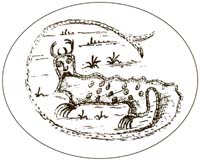
Drawing of Piasa observed by Jacques Marquette and Louis Jolliet on their 1673 voyage down the Mississippi River. (from a map drawn by Franquelin, 1678)
![]()
Piasa
While Skirting some rocks, which by Their height and Length inspired awe, We saw upon one of them two painted monsters which at first made Us afraid, and upon Which the boldest savages dare not Long rest their eyes. They are as large As a calf; they have Horns on their heads Like those of deer, a horrible look, red eyes, a beard Like a tiger's, a face somewhat like a man's, a body Covered with scales, and so Long A tail that it winds all around the Body, passing above the head and going back between the legs, ending in a Fish's tail. (Jacques Marquette, 1674)![]()
The cosmology, or world view, of the Illinois was similar in some ways to that of the Cherokee and other southeastern tribes. To these groups, the universe had three levels: an Upper World occupied by gods like the sun and the thunder, a Lower World that was home to serpents and underwater monsters, and a Middle World inhabited by plants, people, and other animals. The rock paintings of strange monsters that Jacques Marquette saw on a Mississippi River bluff in 1673 are depictions of the Piasa, a fearsome supernatural creature that was thought to inhabit the Lower World. Unlike the Cherokee and other southeastern tribes, which thought the earth was suspended by four cords from a sky vault made of stone, the Illinois believed the earth rested on the back of an otter.
|
|
Copyright © 2000 Illinois State Museum
